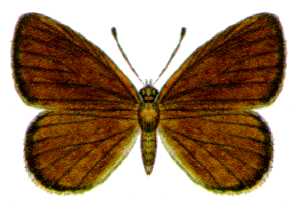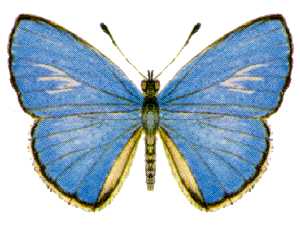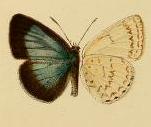
Candalides is a large genus of butterflies in the family Lycaenidae. The species of this genus are found in the Australasian realm.

Candalides absimilis, the pencilled blue or common pencil-blue, is a species of butterfly of the family Lycaenidae. It is found along the east coast of Australia, including Queensland, the Australian Capital Territory, New South Wales and Victoria.

Candalides acasta, the blotched blue, is a species of butterfly of the family Lycaenidae. It is found in southern Australia, including Queensland, New South Wales, Victoria, Tasmania, South Australia and Western Australia.

Candalides xanthospilos, the yellow-spot blue, is a species of butterfly of the family Lycaenidae. It is found in along the eastern coast of Australia, including Queensland, New South Wales and Victoria.

Candalides heathi, the rayed blue, is a species of butterfly of the family Lycaenidae. It is found in southern Australia, including South Australia, New South Wales and Victoria.

Candalides hyacinthina, the varied dusky-blue, is a species of butterfly of the family Lycaenidae. It is found along the east coast of Australia, including South Australia, New South Wales, Western Australia and Victoria.

Candalides cyprotus, the cyprotus blue or copper pencil-blue, is a species of butterfly of the family Lycaenidae. It is found along the east coast of Australia, including South Australia, New South Wales, Western Australia and Victoria.

Candalides erinus, the small dusky-blue, is a species of butterfly of the family Lycaenidae. It is found in Australia and Indonesia.

Candalides helenita, the shining pencil-blue, is a species of butterfly of the family Lycaenidae. It is found in Australia and Indonesia.

Candalides gilberti, the northern pencil-blue, is a species of butterfly of the family Lycaenidae. It is found in Australia in the Northern Territory and the north of Western Australia.

Candalides grandissima is a species of butterfly of the family Lycaenidae. It is found in New Guinea.

Candalides neurapacuna is a species of butterfly of the family Lycaenidae. It is found from southern New Guinea to south-eastern Papua New Guinea.
Candalides lamia is a species of butterfly of the family Lycaenidae. It was described by Henley Grose-Smith in 1897. It is found in Papua New Guinea on Fergusson Island and Goodenough Island.
Candalides silicea is a species of butterfly of the family Lycaenidae. It was described by Henley Grose-Smith in 1894. It is found in the Schouten Islands and Mefor Island in New Guinea.
Candalides tringa is a species of butterfly of the family Lycaenidae. It was described by Henley Grose-Smith in 1894. It is found in West Irian.
Candalides consimilis, the consimilis blue, is a species of butterfly of the family Lycaenidae. It was described by Gustavus Athol Waterhouse in 1942. It is found in Australia.

Candalides margarita, or Margarita's blue, is a species of butterfly of the family Lycaenidae. It was described by Georg Semper in 1879. It is found in Australia and New Guinea.

Harpullia hillii, commonly known as blunt-leaved tulip or oblong-leaved tulip, is a tree in the family Sapindaceae, endemic to eastern Australia. It occurs in dry rainforest from the Burdekin River in Queensland southwards to Wauchope, New South Wales.











